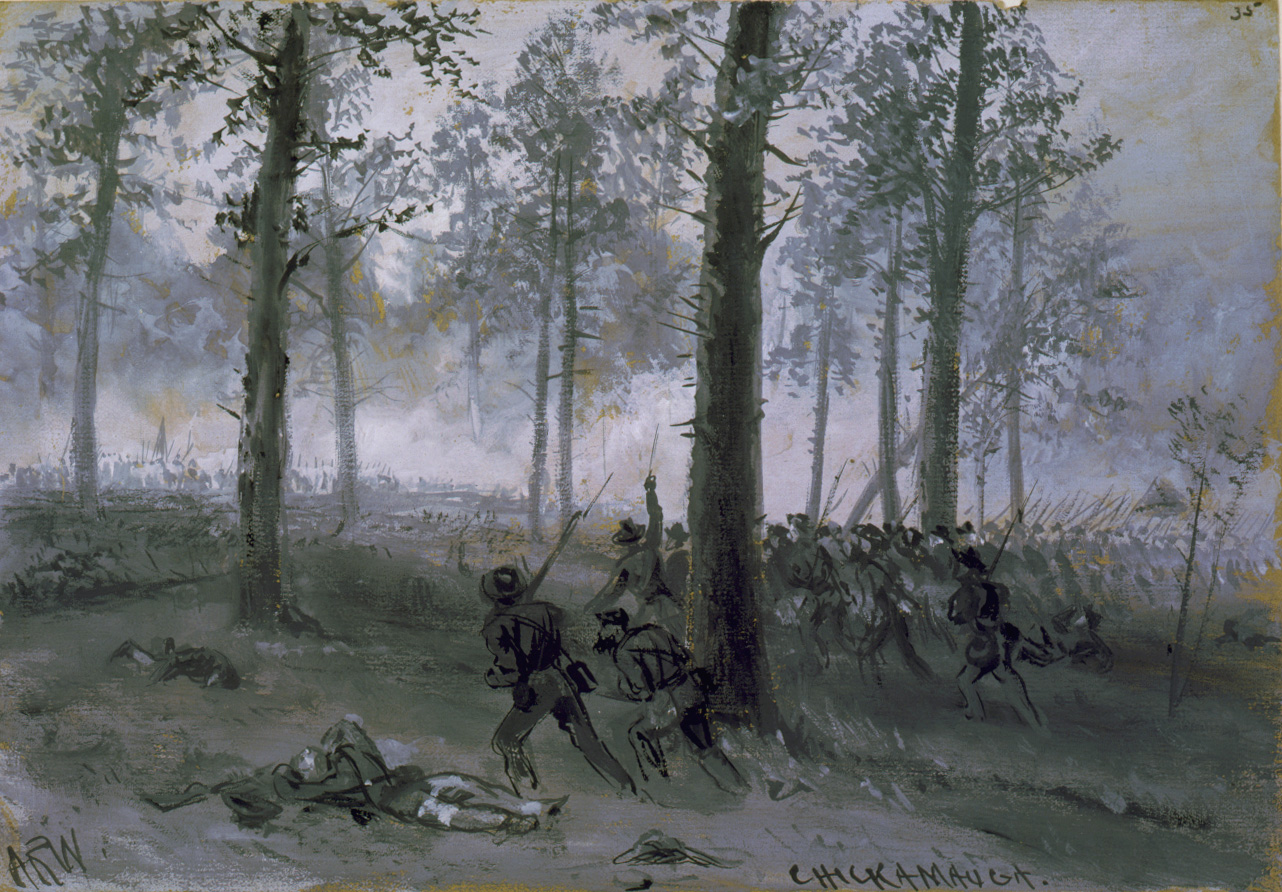20 September 1863
 •
by
•
by Leviathann

Battle of Chickamauga
Date: September 19–20, 1863
Location: Catoosa County and Walker County, Georgia
Result: Confederate victory
Belligerents
United States (Union)
CSA (Confederacy)
Commanders and leaders
William S. Rosecrans (Union)
Braxton Bragg (CSA)
Units involved
Army of the Cumberland (Union)
Army of Tennessee (CSA)
Strength
approx. 60,000 (Union)
approx. 65,000 (CSA)
Casualties and losses
(Union)
16,170
(1,657 killed
9,756 wounded
4,757 captured/missing)
(CSA)
18,454
(2,312 killed
14,674 wounded
1,468 captured/missing)

Rosecrans (Union) (left)
Bragg (CSA) (right)
In one of the bloodiest battles of the war, the Confederate Army of Tennessee drives the Union Army of the Cumberland back into Chattanooga, Tennessee, from Chickamauga Creek in northern Georgia. Although technically a Confederate victory, the battle had little long-term effect on the military situation in the region.
During the summer of 1863, Union General William Rosecrans had outmaneuvered Confederate General Braxton Bragg (For which Fort Bragg, NC is named.) Without fighting any major battles, Rosecrans had moved Bragg out of Tullahoma, Tennessee, and, by September, had captured Chattanooga. Pursuing Bragg into the mountainous region of northern Georgia, Rosecrans gleaned information from Confederate deserters that indicated Bragg was retreating. However, this information was false and had been deliberately fed to the Yankees.
Bragg had hoped to attack Rosecrans and drive the Federals south, away from Chattanooga and Union supply lines. On September 19, a division from Union General George Thomas's corps moved out to strike at what Thomas thought was an isolated Confederate brigade. But his force ran into dismounted Rebel cavalry, and the battle escalated when Bragg sent additional troops to the skirmish. As the day wore on, the battle spread down the lines until both armies were fully engaged.
That night, additional Confederate troops arrived under the command of James Longstreet. Longstreet was part of Robert E. Lee's Army of Northern Virginia, and his men had fought at Gettysburg, Pennsylvania, two months prior. He was dispatched with two of his divisions to stem the tide of Confederate defeat in the West.
Longstreet's appearance paid off for the Confederates. Around noon on September 20, the stalemate broke when Rosecrans ordered General Thomas Wood to move his division to plug a gap in the Yankee line. Although no such gap existed, one was created when Wood moved his division. Longstreet's troops were now able to march through the gap, and the Union line collapsed in chaos. Most of the Union army began a hasty retreat to nearby Chattanooga, leaving Thomas's corps alone on the battlefield. Thomas stubbornly held his ground and halted the Rebel attack, which allowed him to successfully withdraw without further losses. His action earned him the nickname "The Rock of Chickamauga."
Bragg did not immediately pursue Rosecrans to Chattanooga. Instead, the Confederates besieged the city until Union reinforcements arrived in late October. One of the largest battles of the war, Chickamauga resulted in 18,500 Confederate casualties and 16,100 Union casualties.

Drawing of advancing Confederates.
PS: If you like my articles, in addition to voting and subscribing, please add me to your friends list. Thanks!


Comments
Don't pretend to be a conservative when you ally against most of the ardent RL conservatives in the eUSA who are with me.
Pizza, seriously, stfu.
Pizza, despite what delusions you may be suffering from, in this game, you aren't even close to being "conservative", In fact, you're pretty much the complete opposite. So it stands to reason that if Leviathann is a true conservative, his only logical action would be to ally against you.
con·serv·a·tive [kuhn-sur-vuh-tiv]
adjective
1.
disposed to preserve existing conditions, institutions, etc., or to restore traditional ones, and to limit change.
2.
cautiously moderate or purposefully low: a conservative estimate.
3.
traditional in style or manner; avoiding novelty or showiness: conservative suit.
conservatives stand up for LIBERTY like we do.
Stop using politics as an excuse to troll.
GAWFUNAHAK!
That should keep him busy trying to figure out the acronym. xD
@TP, it does no go to explain your point using the definition of the word Conservative. As Pizza has just proven, he has ignored you post completely and continues to misuse the word to his advantage (or so he thinks).
Ok first off this article could be reported (I won't do it) because it is all RL and Admin hate that.
Second, Ajay where in this article did you see anything on politics?
Where?
Third, I don't know about Leviathan but I also consider myself a Conservative. Yes I do stand up for liberty, I am pro-life, I am a Capitalist, and I listen to Glenn Beck. But what the hell does that have to do with a battle in the Civil War?
I was taking a shit and I seriously thought, "Where were YOU on the 20th of September 1863?"
Oh the irony
One damned Yankee--
Voted, subbed, and friended!
Sir, you have as much of my respect as can be mustered for a Reb.
P.S.: do slip in something game relevant in future reports, so you don't run afoul of the law. for instance, a link to the DoD and a recruitment pic ("if you're not in a military or militia, you're doing it wrong") would be minimal yet conforming.